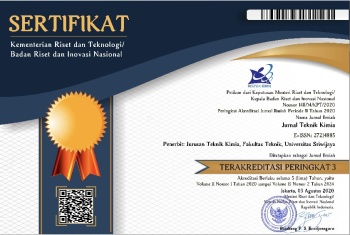Remidiation of sodium hydrogen sulphide rayon waste by oxidation method
Abstract
The mechanism of the oxidation reaction at various concentrations of sulfide waste is dominated by the direct reaction between sulfide waste and hydrogen peroxide to reduce NaHS compounds. This mechanism is an optimal and economical waste elimination method for reducing sulfur in rayon waste. Sodium hydrogen sulfide is easily oxidized with oxygen in the air so that a substance will form which triggers air and water pollution through an increase in the value of chemical oxygen demand. This study aims to determine the effect of adding an oxidizing agent on the rate of reduction of sulfide compounds, the effect of pH, temperature, reaction time between the oxidizing agent and sulfide waste, the amount of oxidizing agent and total sulfur concentration and to model experimental data mathematically. In this study, the kinetic equations and activation energies of H2O2 and NaHS were determined based on the total sulfur and sulfate in non-catalytic and catalytic oxidation reaction solutions. The percentage of sulfide removal is influenced by the initial sulfide waste concentration and the NaHS/H2O2 ratio. The NaHS/H2O2 ratio of 1 : 17.5 gave the best sulfide removal percentage of 89.95% with an initial sulfide waste concentration of 6,136 mg/L. Non-isothermal, isothermal and catalytic oxidation reactions did not show a different percentage of sulfide reduction, which was in the range of 76 - 85%. The optimum NaHS/H2O2 ratio composition can determine optimal conditions for air pollution control, corrosion levels and waste treatment costs as a result of the formation of spent sulfidic caustic compounds consisting of sulfur ions, sulfate ions, etc. Oxidation of sulfides to sulfates by H2O2 can be applied to sulfide waste containing SH- ions.
References

This work is licensed under a Creative Commons Attribution 4.0 International License.










